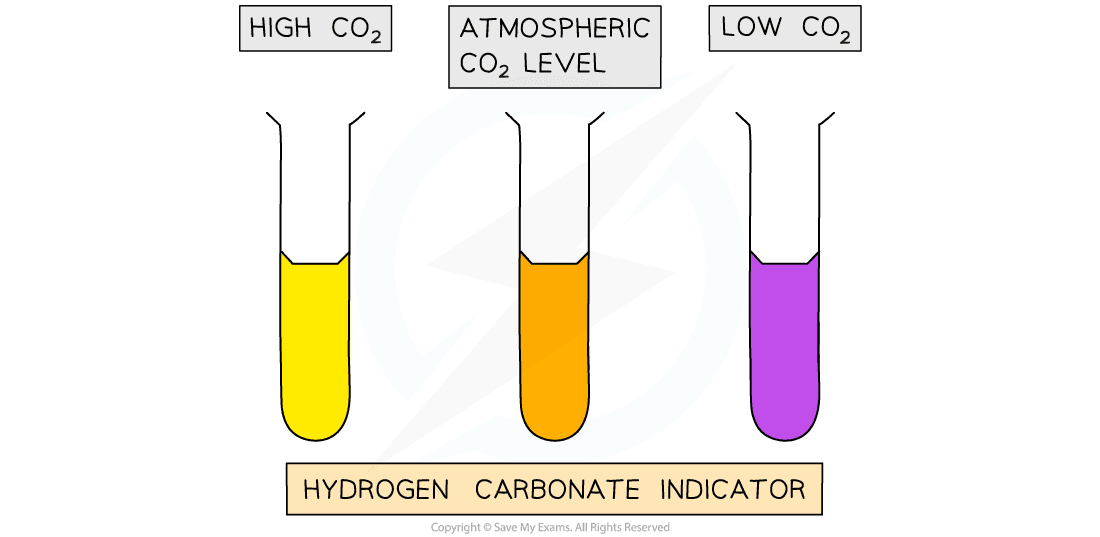Practical: Investigating Respiration
- We can investigate the production of carbon dioxide and heat from respiration through experiments using germinating seeds or other living organisms such as woodlice
Practical investigation: demonstrating the production of carbon dioxide
Apparatus
- Boiling tubes
- Rubber bungs
- Hydrogen carbonate indicator solution
- Cotton wool
- Glass beads
- Germinating seeds
- Boiled/dead seeds
Method
- Measure out 10 cm3 of hydrogencarbonate indicator into 3 boiling tubes
- Put in a layer of cotton wool
- Place 10 germinating seeds in tube A
- Place 10 boiled/dead seeds in tube B
- Place 10 glass beads in tube C
- Seal each tube with a rubber bung
- After 3 hours, observe the colour of the indicator
Hydrogencarbonate indicator
- Hydrogencarbonate indicator is orange in atmospheric CO2 levels
- In high CO2 levels the indicator absorbs the CO2 and becomes yellow
- In low CO2 levels it loses CO2 and becomes purple

Colour results for hydrogen carbonate indicator
Results
- In this investigation, we would expect to note the following
- Tube A should turn yellow as the seeds are respiring and producing carbon dioxide
- Tube B should remain orange as the dead seeds produce no carbon dioxide
- Tube C should remain orange as there is no living material in there


Experiment to demonstrate the production of carbon dioxide by living material during respiration
Practical investigation: demonstrating the production of heat
Apparatus
- Vacuum Flasks
- Thermometer
- Cotton wool
- Germinating seeds
- Dead/boiled seeds
Method
- Set up the flasks as shown in the diagram
- Flask A with the germinating seeds
- Flask B with the dead seeds
- Make sure the cotton wool is plugging the top of each flask
- Hold the thermometer in place with the cotton wool
- Invert the flask
- Record the initial temperature
- After 4 days, record the final temperature

Experiment to demonstrate the production of heat by living material during respiration
Results
- The thermometer in the flask with the germinating seeds (Flask B) should show an increase in temperature
- Flask A should remain at room temperature
- This is because the seeds in flask B are respiring and producing heat energy in the process
- This shows that respiration is an exothermic reaction
- The seeds in flask A are not respiring because they are dead, so the temperature remains the same
Applying CORMS evaluation to practical work
- When working with practical investigations, remember to consider your CORMS evaluation

CORMS evaluation
- In the first investigation, your evaluation should look something like this:
- Change – We will change the content of the boiling tube (germinating seeds, dead seeds or glass beads)
- Organisms – The seeds used should all be of the same age, size and species
- Repeat – We will repeat the investigation several times to ensure our results are reliable
- Measurement 1 – We will observe the change in the hydrogen carbonate indicator
- Measurement 2 – …after 3 hours
- Same – We will control the volume of hydrogen carbonate indicator, the number of seeds/beads, the temperature of the environment
- For the second investigation, your evaluation should look something like this:
- Change – We will change the content of the flasks (germinating seeds or dead seeds)
- Organisms – The seeds used should all be of the same age, size and species
- Repeat – We will repeat the investigation several times to ensure our results are reliable
- Measurement 1 – We will observe the change in the temperature on the thermometer
- Measurement 2 – …after 4 days
- Same – We will control the number of seeds, the starting temperature of the flasks, the material and size of the flasks

